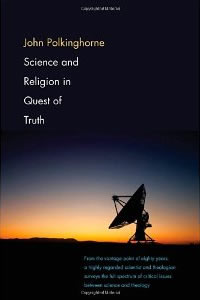Book Notes
 John Polkinghorne, Science and Religion in Quest of Truth (New Haven: Yale University Press, 2011), 143pp.
John Polkinghorne, Science and Religion in Quest of Truth (New Haven: Yale University Press, 2011), 143pp.
You could make a good argument that John Polkinghorne (b. 1930) is the leading light in the study of the relationship between science and religion. From 1968 to 1979 he was professor of mathematical physics at Cambridge University and wrote five books. He then left physics to study for the Anglican priesthood and was ordained in 1982. After five years of ministry, he served as president of Queens' College, Cambridge from 1988 until retirement in 1996. His many honors and awards include knighthood, the Templeton Prize, and the Gifford Lectures.
Polkinghorne has written 26 books on the relationship between science and religion. Science and Religion in Quest of Truth represents his mature thought after a life time of thinking about the subject. He doesn't break any new ground here, but instead offers a hundred-page synopsis and synthesis of what he considers to be the main themes of the discipline. It's an excellent overview and introduction to the subject.
Polkinghorne argues for the unity of all knowledge. For him science and religion are "colleagues in a common quest for truth." In the fourfold taxonomy of Ian Barbour, he favors dialogue between the two disciplines rather than conflict, independence or integration. Science has succeeded precisely because of its narrow purview and the "modesty of its ambition." Science is not the only way to know or the only thing worth knowing. Matters of meaning, value, and beauty, for example, lie outside its scope. All scientific facts are interpreted facts, rely on a circular interplay between theory and experiment, and are based upon prior assumptions such as the rational intelligibility of reality.
The heart of the book reviews the main contributions of each discipline to the other. Chapter 3 considers six gifts of science to theology — causality, relationality and holism, cosmology, evolution, time and consciousness. Chapter 4 considers theology's contributions to science — natural theology, creation, evolution, the problem of evil, providence, prayer, miracles, eschatology, revelation and scripture. Both disciplines aim for "well-motivated belief," that is, not irrefutable proofs but "the most economic, coherent, adequately comprehensive and intellectually satisfying understanding of the rich range of human experience of reality."
Even though this is an introductory text, I still found the science material difficult. What Polkinghorne gains in breadth he sacrifices in depth. But he's unfailingly fair minded, well-informed, modest in tone, confident, and irenic. On any given subject he explains the level of clarity, controversy, debate, and speculation involved. Polkinghorne is also an excellent writer. This volume is a wonderful resource to begin the study of one of the most important subjects of our time.


